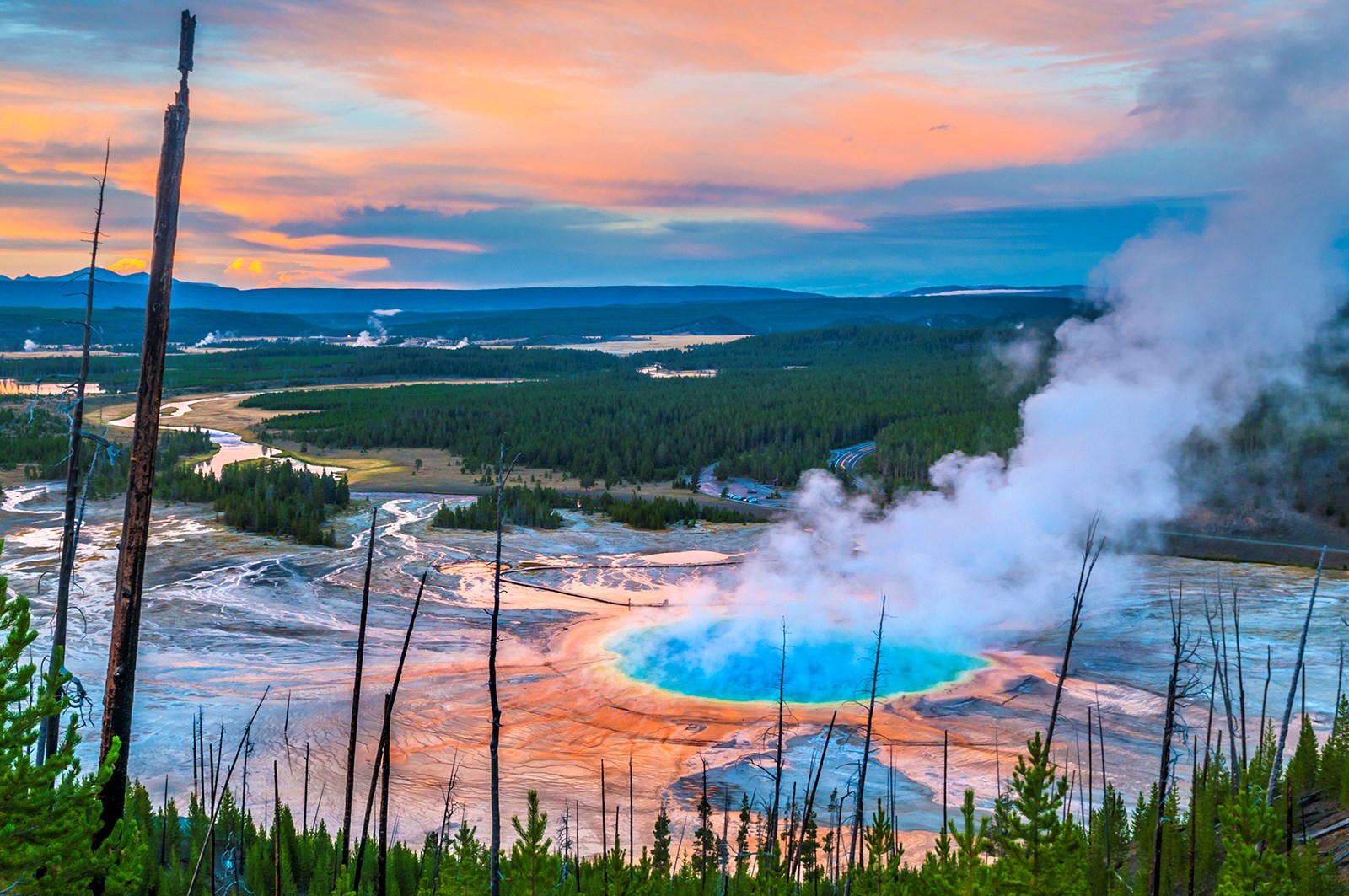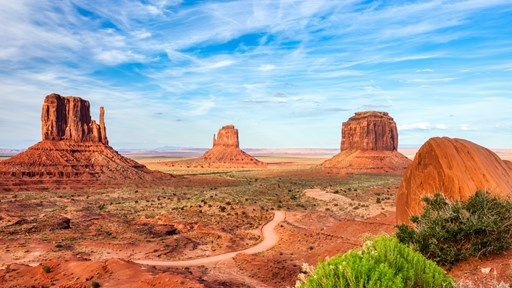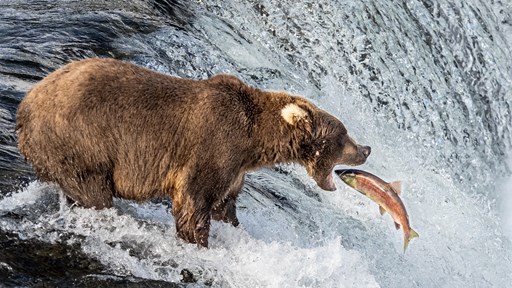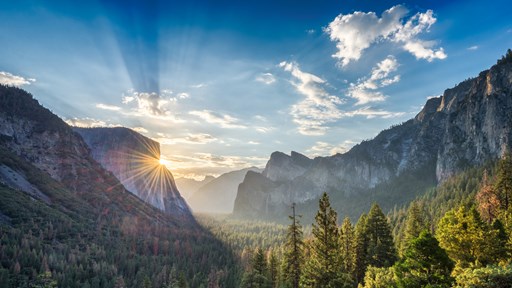If you are ready to see some of the most unique and breathtaking natural features of your life, Yellowstone National Park is an excellent choice. As the United States’ first national park and one of the largest, it is jam-packed with sights and activities for every type of traveler — from stunning viewpoints and relaxing hideaways to adventurous hikes and geological intrigue.
You can see many of the park’s biggest hits in just a few days, but if you have more, you can also explore some hidden gems. We have outlined these stops in a free Yellowstone National Park travel guide and itinerary for three-, four- and five-day trips.

3-Day Yellowstone Itinerary
This Yellowstone National Park itinerary can start in a few different places since the massive park has five entrances. Consider making your home base in the western portion of the park, where you will have quick access to many different activities. Depending on where you come from and when you arrive, you could adapt this first day from the West Entrance, North Entrance or Northeast Entrance. For reference, Yellowstone’s main road runs in a vertical figure eight.
The first part of this three-day Yellowstone itinerary starts with a bang in an area chock-full of geysers. You will see plenty of them on this trip, including the classic Old Faithful and stunning Grand Prismatic Spring. Other highlights of a Yellowstone three-day itinerary include Mammoth Hot Springs, Lamar Valley and the Grand Canyon of the Yellowstone.
Day 1: Geysers Galore
Grab your National Park Pass and head up toward Mammoth Hot Springs. From here, your itinerary for three days in Yellowstone begins with a busy day of geothermal features:
- Mammoth Hot Springs Lower Terrace: These dreamy, white and orange limestone rocks create unique formations with water from the hot spring trickling over the surface and turning into steam. If you can get there bright and early, you will get a beautiful, steamy view and may even hear some eerie elk calls. Spend about an hour walking through the Lower Terrace boardwalks, then head to your next stop.
- Norris Geyser Basin: The Norris Geyser Basin is another otherworldly experience. It is home to the hottest geothermal area in the park and some rare acidic geysers. This area is split into the Porcelain Basin and the Back Basin. In a Yellowstone National Park itinerary for three days, you can stick to the Porcelain Basin. Here, you will see steam rising across the landscape amid milky, bubbly pools that hiss and spit. Expect to spend around an hour touring the quarter-mile boardwalk.
- Midway Geyser Basin and Grand Prismatic Spring: The Grand Prismatic Spring is one of the most famous parts of Yellowstone, offering a breathtaking jewel-toned spring that is bigger than a football field and deeper than a 10-story building. See it up close with the Midway Geyser Basin boardwalk, which takes around a half hour to traverse and passes a huge geyser crater, the Opal Pool and the Turquoise Pool. For a gorgeous overhead view, take a half-mile hike on Fairy Falls Trail.
- Old Faithful and the Upper Geyser Basin: Grab a late lunch in the area surrounding Old Faithful, then get ready for the show. No Yellowstone travel guide would be complete without this famous geyser, which earned its name with a predictable schedule of eruptions about every 90 minutes. After the eruption, you can wander around the Upper Geyser Basin to see other thermal features like the Riverside Geyser and the Chromatic Pool.
- Black Sand Basin: Before calling it a day, stop by Black Sand Basin, named for the dark obsidian sand formed from cooling lava. Alongside the sand, you will see extremely vibrant colors in thermal features, including the Emerald Pool, Rainbow Pool, Opalescent Pool and Cliff Geyser. Another short half-mile hike takes you around these sights.
Finish the first day of your three-day itinerary in Yellowstone with a tranquil stay in nature. Whether you are traveling via RV, want to camp in a tent or prefer a cabin, Kampgrounds of America has options.
Just outside the West Entrance is Yellowstone Park / West Gate KOA Holiday, with its shady pines and gorgeous views. A bit further west is the Yellowstone Park / Mountainside KOA Journey, nestled amid mountain streams, fishing ponds and old-growth pine trees. Both offer plenty of amenities for a comfortable stay, like RV hookups, on-site food options and Wi-Fi.
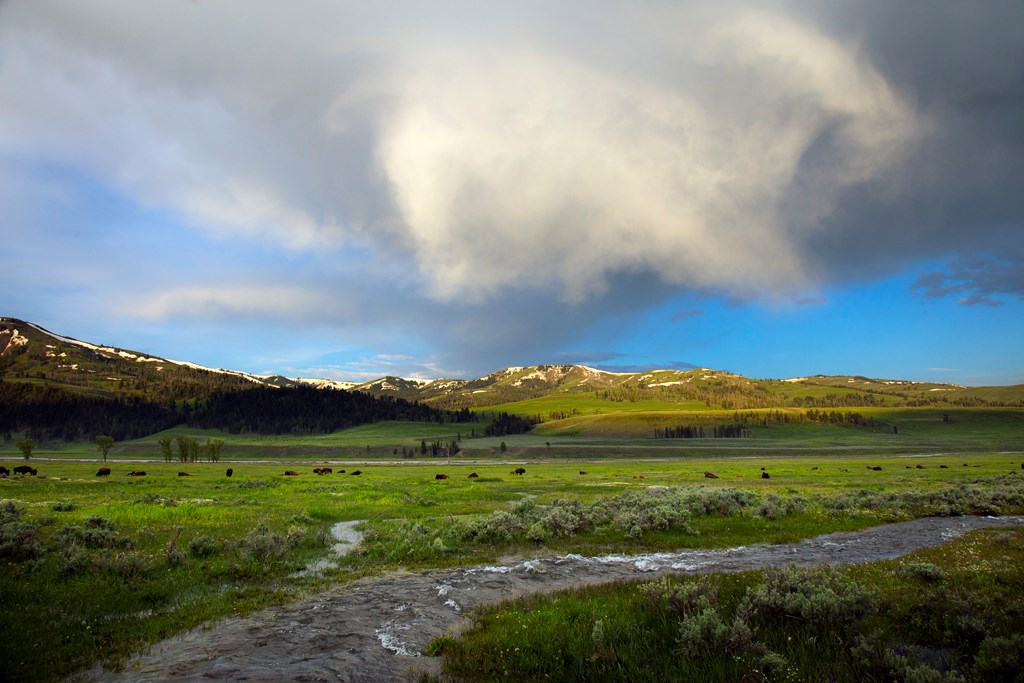
Day 2: Wildlife and Waterfalls
You will start the second day of this Yellowstone Park travel guide with perhaps the park’s best spot for viewing wildlife, along with the rocky area dubbed the Grand Canyon of the Yellowstone. Animals you might see in the well-preserved landscape of the park include bison, elk, moose, eagles, wolves, pronghorn and even bears.
You will need to keep your distance, so consider getting a pair of binoculars or a spotting scope to see them more clearly. If you are exploring the park with kids, have them keep their eyes peeled on your driving safari.
As you drive through these areas, you will often see crowds of people gathering on the side of the roads. When you do, pull over and investigate, because they are probably looking at an animal. Also, leave yourself plenty of time to get through the area because bison herds can block the roads as they cross — not the worst reason to get stuck in traffic!
You will start the second day of your three-day Yellowstone itinerary a bit further away and work your way back toward the West Entrance. Grab a coffee for the two-hour drive to a breathtaking experience in Lamar Valley:
- Lamar Valley: Lamar Valley offers prime wildlife viewing and is sometimes called America’s Serengeti. You can find many animals here, including bison, pronghorn, coyotes and more. If you are lucky, you might even see some wolves or bears. Experiencing the valley takes less than an hour if you drive straight through, but you will loop back around at the end. You will also need to consider pulling off to view animals and the possibility of a bison traffic jam. Plan on spending two or three hours here.
- Calcite Springs Overlook: Head south and stop at the Calcite Springs Overlook, where the rich blue of the Yellowstone River contrasts with the area’s pastel orange rocks and milky white calcite deposits. You can reach the viewpoint after a half-mile walk from the parking lot.
- Tower Falls: Tower Falls is another accessible stop right off the highway. A 150-yard walk takes you right to a stunning view of this 132-foot-tall waterfall. Grab a pic and head to your last stop of the day.
- Canyon Village and the Grand Canyon of the Yellowstone: After a morning in the car, grab a late lunch at Canyon Village and get ready to stretch your legs. The Grand Canyon of the Yellowstone has many viewpoints you can drive or hike to. Artist Point is the most famous overlook, with a view straight down the canyon that includes the 300-foot Lower Falls waterfall. Other worthy stops in the canyon include Lookout Point, Red Rock Point, Brink of the Upper Falls and Canyon Overlook.
After a day of stunning views, you can return to your stay for a relaxing evening around a campfire or explore the charming town of West Yellowstone.
Day 3: Southwest Exploring
On your last day in the park, head over to Yellowstone Lake in the southeast area for a little bit of everything. This day includes some activities, more geothermal features and another wildlife viewing spot.
Start the day with about a 90-minute drive from the West Entrance to the West Thumb Geyser Basin:
- West Thumb Geyser Basin: Situated on the edge of Lake Yellowstone, this basin has several beautiful hot springs and geysers. Take the 0.6-mile loop trail around the area and see Abyss Pool and Black Pool, which has changed over time from black to bright blue. Fishing Cone is an interesting sight where people used to toss fish they caught in the lake for easy cooking.
- Mud Volcano: Mud Volcano is another geyser area, but the features here are thick and opaque with mud. A short walk from the parking lot is the Mud Volcano itself, along with the Mud Cauldron and Mud Geyser. You can also find Dragon’s Mouth Spring, where boiling water ate away part of the hillside.
- Yellowstone Lake: While this high-altitude lake is too cold for swimming, it offers a scenic drive with lovely roadside viewpoints. In some areas, you will also see the Absaroka Mountains in the distance. Head to Bridge Bay and spend a few hours on the water. You can take a scenic cruise, do some fishing or go kayaking. The nearby Lake Village is a good spot for lunch.
- Hayden Valley: Heading away from the lake is Hayden Valley, another excellent place for viewing wildlife. As you drive through this scenic area, you can find plenty of animals. While a straightforward drive is only about 15 minutes, you can easily spend an hour or more in this area.
- West Yellowstone Experiences: If you are not tired of adventuring, head back to the West Yellowstone area for some exciting activities. Many local businesses offer experiences like zip lining, horseback riding, whitewater rafting and biking.
Get back for a good night’s sleep to recharge after squeezing in the highlights of Yellowstone National Park in just three days!

4-Day Yellowstone Itinerary
This Yellowstone National Park itinerary for four days includes similar attractions but gives you more time to spend on the incredibly diverse geothermal areas. It splits the eastern side of the park into two days and keeps the last day the same as the three-day itinerary.
Day 1: Northwest Geothermal Features
With an extra day in the park, you can hit more geysers on the western side. Explore the other parts of Mammoth Hot Springs and the Norris Geyser Basin, and stop by the Artist’s Paintpots. Here is what you can see in those places:
- The Upper Terrace at Mammoth Hot Springs: Although you walk the Mammoth Hot Springs’ Lower Terrace, you can stay in your car for the 1.5-mile Upper Terrace Drive. Unfortunately, motor homes and trailers cannot enter this narrow roadway, but you can park them and make the hike on foot. Up here, you can see areas like Orange Spring Mound and Angel Terrace.
- The Back Basin at Norris Geyser Basin: While the Porcelain Basin is mostly open space, the Back Basin takes you through a wooded area dotted with geothermal features. Most of these geysers are erratic, including the Steamboat Geyser, which rises 300 feet and is the world’s tallest active geyser. You probably will not see it erupt, but the trail takes you past several vibrant and colorful sights, like Emerald Spring, Cistern Spring and the Echinus Geyser.
- Artists’ Paintpots: South of the Norris Geyser Basin is this steamy collection of various geothermal features. The area’s namesake comes from the mudpots that bubble and spit thick mud in vibrant colors. Some milky-blue pools and deep red sulfur deposits help create a colorful, dynamic scene in a short trail.
With these sights added, you can stop the first day after the Paintpots. Altogether, you will visit Mammoth Hot Springs, Norris Geyser Basin and the Artists’ Paintpots.
Day 2: Lower, Middle and Upper Geyser Basins
The four-day Yellowstone itinerary lets you see all three of the large geyser basins in the park. Start with the one not included on the three-day itinerary: the Fountain Paint Pot Trail in the Lower Geyser Basin. This trail has an array of thermal features within about a half-hour walk. You can see the Celestine Pool, the Clepsydra Geyser, the Fountain Paint Pots and the Silex Spring.
After, head to the Grand Prismatic Spring. You can see it from the ground and overhead from Fairy Falls Trail to get both stunning views. Finish up with Old Faithful and the Black Sand Basin.
Day 3 and Day 4: Eastern Yellowstone
The third and fourth days of this itinerary are the same as days two and four listed above. You will see Lamar Valley, Calcite Springs Overlook, Tower Falls and the Grand Canyon of the Yellowstone on day three. On day four, head to the West Thumb Geyser Basin, Mud Volcano, Yellowstone Lake, Hayden Valley and West Yellowstone.
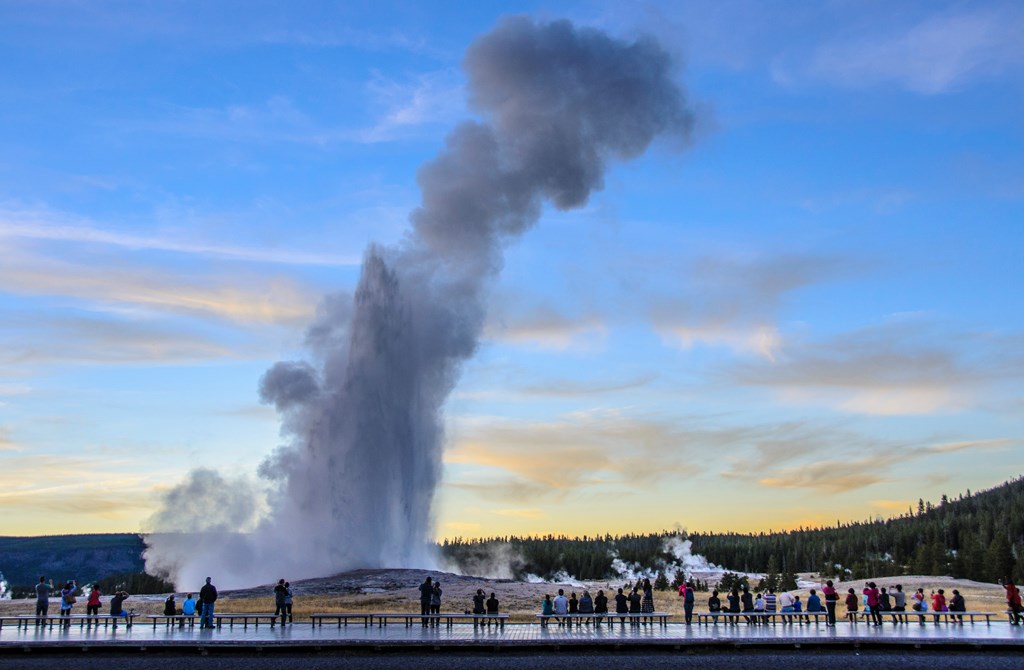
5-Day Yellowstone Itinerary
A Yellowstone National Park itinerary for five days is perfect for people more interested in hikes or activities. Here is how you can adjust the other schedules for a Yellowstone five-day itinerary:
- Day 1: After seeing both terraces of Mammoth Hot Springs, take a quick detour to Undine Falls, a beautiful spot with a viewpoint just off the road. You can also stop at Wraith Falls, which is a half-mile walk from the parking lot, and see Sheepeater Cliff, a unique cliff of basalt columns. Then, see both parts of Norris Geyser Basin and head back toward the West Entrance.
- Day 2: Visit the Artists’ Paintpots, the Fountain Paint Pot Trail and the Grand Prismatic Spring. On your way back to West Yellowstone, stop at Firehole Canyon to see Firehole Falls and hop in the swimming hole.
- Day 3: Visit Old Faithful and the Black Sand Basin on your way to the West Thumb Geyser Basin and the Mud Volcano.
- Day 4:. Start the day in Lamar Valley and work your back toward Calcite Springs Overlook and Tower Falls. Consider a drive through Mount Washburn for some beautiful high-altitude views before you reach the Grand Canyon of the Yellowstone. Use your afternoon for an activity like zip lining, rafting or a longer hike through the canyon.
- Day 5: Finish up your five-day Yellowstone itinerary with a visit to the Grizzly and Wolf Discovery Center in West Yellowstone. Try and spot some of those animals over in Hayden Valley, then head to Yellowstone Lake for some time on the water or to Mount Washburn for a tricky hike.
Book Your National Park Stay With KOA
Despite having so many natural wonders, this park packs it all into a relatively small space, so you can see plenty of sights in three, four or five days. Plus, you can use one place as your home base for easy exploring.
Whatever kind of travel you like, the KOA Family of Campgrounds® has two great options in West Yellowstone. Try the Yellowstone Park / Mountainside KOA Journey for an easy stay after a long day of adventuring, or the Yellowstone Park / West Gate KOA Holiday for a perfect base camp, complete with amenities like a pool, laundry room and playground. Book your stay today, or explore KOA locations across the United States to complete your road trip!
About the Author: Kampgrounds of America
Kampgrounds of America is the largest system of open-to-the-public campgrounds in the world, with over 500 locations across the United States and Canada. Founded in Billings, MT in 1962, KOA’s family of campground brands – KOA Journey, KOA Holiday and KOA Resort – today serve more than a million camping families each year. KOA is dedicated to “connecting people to the outdoors and each other” by providing people with a variety of camping experiences and the information they need to make the most of their camping trip. Read more of their camping and travel resources by visiting KOA.com/blog.



















